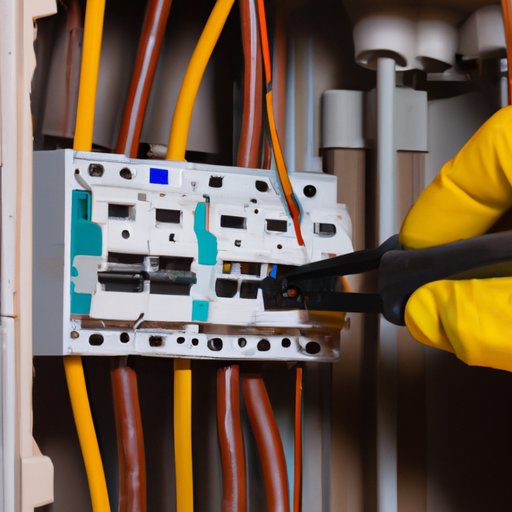
I. Introduction
Breakers are an essential part of any electrical system. They help protect the system from short circuits and other electrical damage that can occur regularly. If you experience an outage, you may encounter a tripped breaker, which prevents the system from operating. Resetting a breaker is a necessary skill that every homeowner should know. In this article, we will provide a comprehensive guide on how to reset a breaker, common scenarios that may cause a breaker to trip, and ways to prevent these breakers’ problems from happening in the future.
II. Step-by-Step Guide to Resetting a Breaker
The first step in resetting a breaker is to locate the breaker panel. This is the large metal box typically located in the utility room or basement. Open the box by unlatching the cover. Inside, you will find several switches, which are your breakers. Look for a switch that is in the “off” position, meaning that it is not pointing in the same direction as the other switches in that row. This switch is most likely the tripped breaker. Power off or unplug any appliances or devices connected to the tripped breaker. Then, push the switch into the “on” position by flipping it to the opposite directions as the other switches in the same row. Check whether power has been restored to the device or appliance you unplugged earlier.
If you flip the switch to the “on” position, but there is no power, it may need further examination. You should turn the breaker back off and contact an electrician to ensure that there are no underlying issues with your electrical system.
III. Reasons to Reset a Breaker
Some common scenarios where a breaker may trip include overloading the circuit or a power surge. An overloaded circuit means that there are too many devices or appliances connected to a particular circuit that may not be able to handle the electrical load. You may also have a tripped breaker because of an electrical surge caused by inclement weather or a faulty device. It’s important to reset a tripped breaker because every electrical system is designed to protect you and your home, and when a breaker is tripped, it means something is wrong. Resetting a breaker only takes a few seconds and can prevent any electrical hazards and potential issues from escalating into a dangerous situation.
IV. Video Tutorials
Videos can be a helpful tool in illustrating the process of resetting a breaker. They offer a visual perspective to the process, making it easier to follow for those who aren’t as familiar with electrical systems. If you would like to create a video tutorial, here are some tips to consider:
- Use clear and concise language
- Make sure it’s well-lit and your voice is audible
- Keep the video length to under two minutes
- Ensure that your steps are easily replicable
V. Common Breaker Problems and How to Fix Them
If you suspect that something is wrong with your breaker, it is essential to diagnose the issue before attempting to reset it. Here are some common issues that may cause a breaker to trip:
- Overloading the circuit
- Short circuits
- Ground faults
- Electrical surges
You can diagnose an overheated circuit by checking the breaker panel’s temperature. If the panel is warm, it’s time to consider redistributing the electricity or replacing the breaker. In the case of short circuits or ground faults, it is recommended that you call a professional for troubleshooting. Electrical surges can be caused by faulty appliances or devices. You can prevent electrical surges by unplugging electronics during lightning storms.
VI. Using the Manufacturer Manual
Your electrical system’s manufacturer’s manual is a helpful resource that outlines how you can reset a tripped breaker and offers some other safety tips. If you can’t find a copy of your manual, you can search for it online or contact the manufacturer for a new copy. Here are some tips to follow when using the manufacturer manual:
- Review the manual carefully and ensure you understand the process before starting.
- Ensure that the manual matches the model of your electrical system
- Follow the manual instructions step-by-step and resist tinkering with anything else as it may lead to further electrical damage.
VII. Preventing Breaker Trips
There are many ways to avoid tripping your breakers. One of the ways is to reduce electrical load on any particular circuit. You can do this by not running multiple high-wattage appliances or devices simultaneously. Another way is to ensure the electrical system is suitable for your home’s need. A professional electrician can check the system’s overloading and recommend updating the panel to avoid tripping. Lastly, you can install surge protectors to all of your electronics and appliances to prevent electrical surges.
VIII. Conclusion
Resetting a tripped breaker can be a daunting task, but it’s essential to ensure your electrical system is functional, safe and avoid potential electrical hazards. Tripped breakers can happen due to different scenarios, including overloading the circuit or electrical surges. Some common breaker issues include short circuits, ground faults, and electrical surges. With some information on how to reset a breaker, you can fix small electrical problems and avoid the need for professional help. Safety is always paramount, and if you have any doubts, we recommend contacting an experienced electrician immediately to ensure that you and your family are safe.




